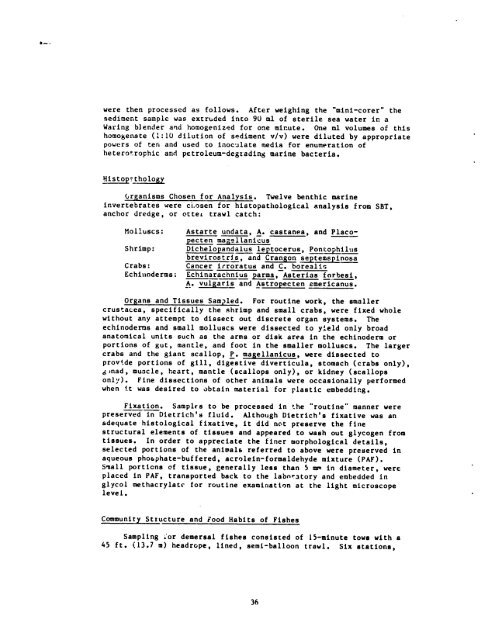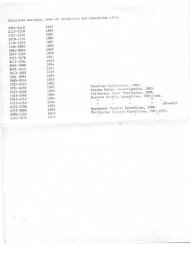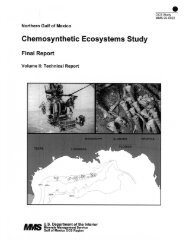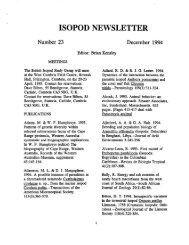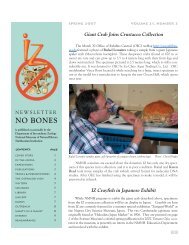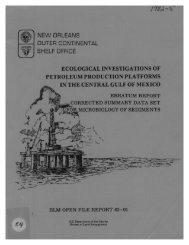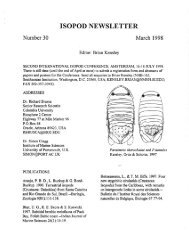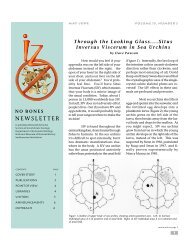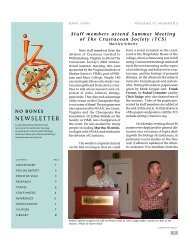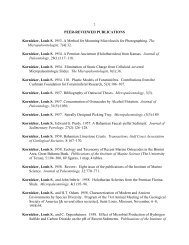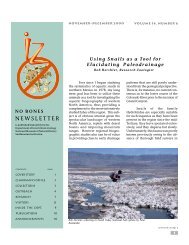Executive Summary - Department of Invertebrate Zoology
Executive Summary - Department of Invertebrate Zoology
Executive Summary - Department of Invertebrate Zoology
Create successful ePaper yourself
Turn your PDF publications into a flip-book with our unique Google optimized e-Paper software.
It ... -<br />
were then processed as follows . After weighing the "mini-corer" the<br />
sediment sample was extruded into 90 ml <strong>of</strong> sterile sea water irn a<br />
Waring blender and homogenized for one minute . One ml volumes <strong>of</strong> this<br />
homogenate (1 :10 dilution <strong>of</strong> sediment v/v) were diluted by appropriate<br />
powers <strong>of</strong> ten and used to inocslate media for enumeration <strong>of</strong><br />
hetero .*.rophic and petroleum-degrading marine bacteria .<br />
Histop t hology<br />
(jrganisms Chosen for Analysis . Twelve benthic marine<br />
invertebrates were ci.osen for histopathological analysis from SBT,<br />
anchor dredge, or ottec trawl catch :<br />
Molluscs : Astarte undata , A . castanea , and Placoep<br />
cten mabellanicus<br />
Shrimp : Dichelopandalus leptocerus , Pontophilus<br />
brevirostr ls, and Cran on septemspinosa<br />
Crabs : Cancer irroratus and C . borealis<br />
Echinoderms : Echinarachnius 21rma, Asterias forbesi ,<br />
A . vulgaris and Astropecten Emericanus .<br />
Organs and Tissues Samled . For routine work, the smaller<br />
crustacea, specifically the shrimp and small crabs, were fixed whole<br />
without any attempt to dissect out discrete organ systems . The<br />
echinoderms and small molluscs were dissected to yield only broad<br />
anatomical units such as the arms or disk area in the echinoderm or<br />
portions <strong>of</strong> gut, mantle, and foot in the smaller molluscs . The larger<br />
crabs and the giant scallop, P . magellanicus, were dissected to<br />
provtde portions <strong>of</strong> gill, digestive diverticula, stomach (crabs only),<br />
s)nad, muscle, heart, mantle (scallops only), or kidney (scallops<br />
only) . Fine dissections <strong>of</strong> other animals were occasionally performed<br />
when it was desired to obtain material for plastic embedding .<br />
Fixation . Samplss to be processed in the "routine" manner were<br />
preserved in Dietrich's fluid . Although Dietrich's fixative was an<br />
adequate histological fixative, it did not preserve the fine<br />
structural elements <strong>of</strong> tissues and appeared to wash out glycogen from<br />
tissues . In order to appreciate the finer morphological details,<br />
selected portions <strong>of</strong> the animalb referred to above were preserved in<br />
aqueous phobphate-buffered, acrolein-formaldehyde mixture (PAF) .<br />
Small portions <strong>of</strong> tissue, generally less than 5 mn in diameter, were<br />
placed in PAF, transported back to the laboratory and embedded in<br />
glycol methacrylate for routine examination at the light microscope<br />
level .<br />
Community Str ucture and Food Habits <strong>of</strong> Fishes<br />
Sampling :or demersal fishes consisted <strong>of</strong> 15-minute tows with a<br />
45 ft . (13 .7 m) headrope, lined, semi-balloon trawl . Six stations,<br />
36


